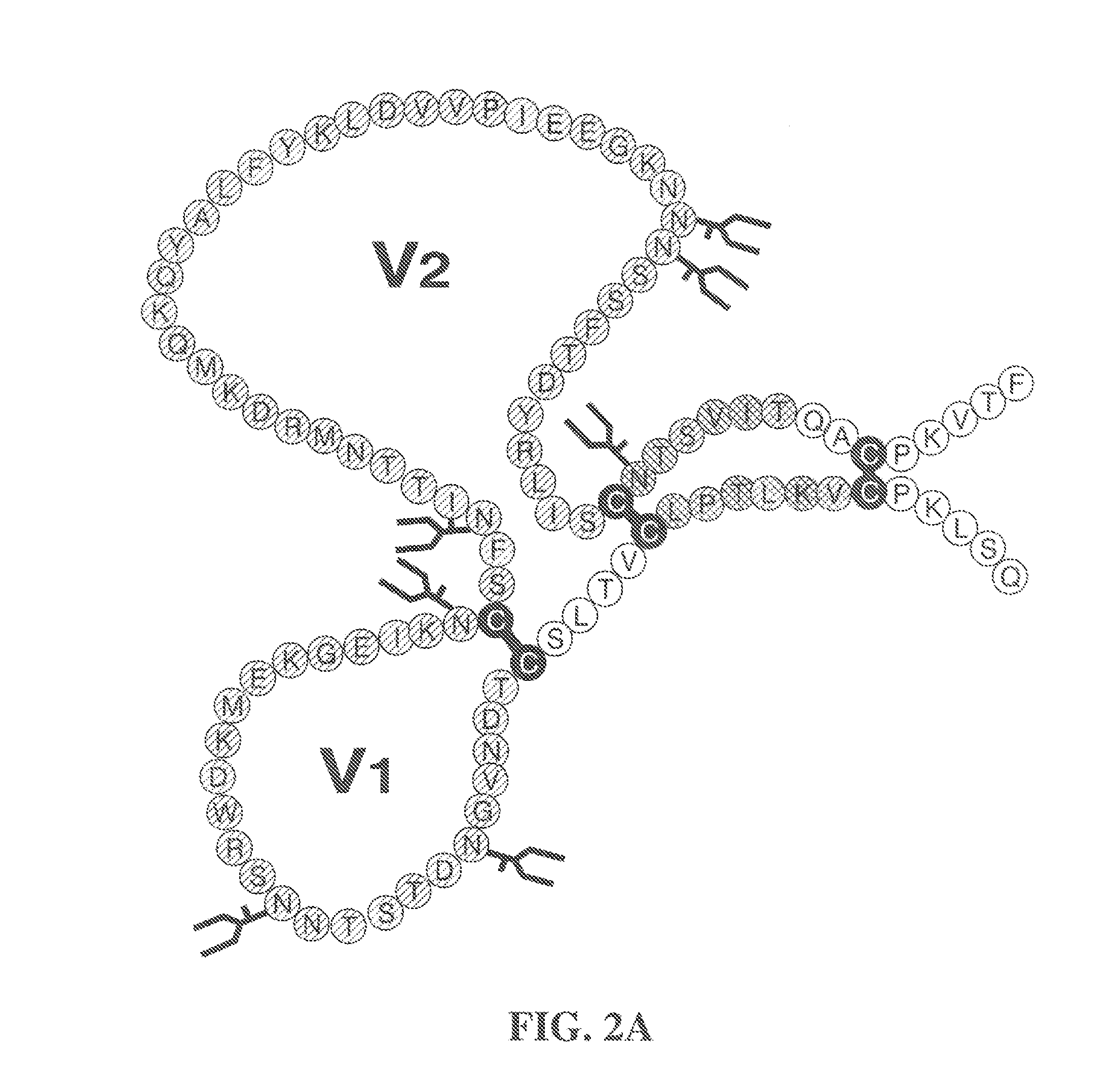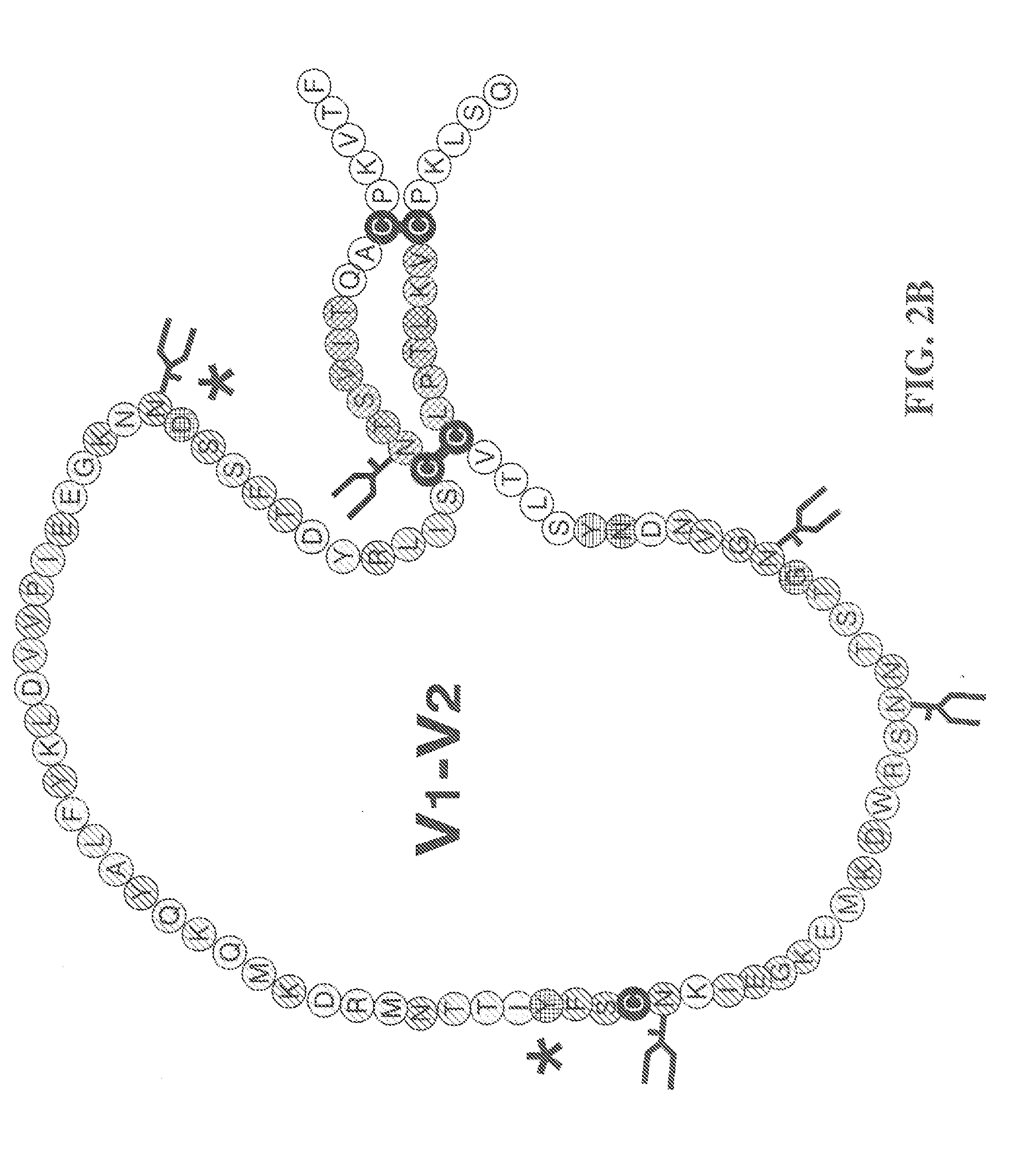Enhanced rapid immunogen selection method for HIV gp120 variants
- Summary
- Abstract
- Description
- Claims
- Application Information
AI Technical Summary
Benefits of technology
Problems solved by technology
Method used
Image
Examples
example 1
Isolation and Affinity of the LR1-C1 Virion to the nAb 4E10
[0216]Mutations were introduced into HIV-1 AC-10 env as described in the methods. A library of chimeric HIV virions was generated by transferring the randomly mutated envelopes into the pNL4-3 plasmid. PCR products were cloned into the vectors pNL4.3 and the recombinant vectors introduced into Stbl2™ competent cells. The isolated HIV-1 env RNA was amplified by reverse transcriptase polymerase chain reaction (RT-PCR). The resulting amplicon (2583 bp) was electrophoresed along with a 1 Kb molecular weight marker. Env-positive clones were sequenced using the primers 183 (forward), 185 (forward), 186 (forward), 190 (reverse), 192 (reverse) and 193 (reverse). Clones expressing envelope glycoproteins capture MAbs-specific with relevant mutations (loss of potential glycosylation sites and changes in the architecture of V1 / V2 loops, see FIG. 2.) were amplified and used to for transient transfection of 293T cells. The binding of 4E10...
example 2
Characterization of the Neutralizing Antibody Response Induced by LR1-C1 in BALB / c Mice
[0217]AC10 virions and virions expressing the Env variant with increased affinity for bNAb 4E10-LR1-C1—were generated by transient transfection into 293T cells and inactivated with aldrithiol-2 (AT-2) with a previously described protocol (Rossio, J. L. et al. Inactivation of human immunodeficiency virus type 1 infectivity with preservation of conformational and functional integrity of virion surface proteins. J Virol 72, 7992-8001, 1998). Two different groups of mice were immunized with AT-2 chemically inactivated virions with Freund's adjuvant. The first group of 4 was inoculated intramuscularly with the WT virus (AC10) and the second group of 5 with the LR1-C1 virions. Serological analysis was performed in both groups at time zero (pre-immunization), 2 weeks after inoculation and 2 weeks later at time of sacrifice. Animals were maintained in specific pathogen free (SPF) conditions, with standard...
example 3
Preparation and Deep Characterization of the L1L2L3R1 Library after Selection with the nAb 4E10
[0221]In-Vitro Random Mutagenesis.
[0222]Mutations were introduced into HIV-1 AC-10 env using a PCR-based method (Genemorph II Random Mutagenesis kit Stratagene, Calif., USA. A library L1L2L3 of chimeric HIV virions was generated by transferring the randomly mutated envelopes into pNL4-3 plasmid. The transfer was mediated by the introduction of restriction sites preserving the virus sequence and digestion with the enzymes XbaI (New England biolabs; NEB, UK) and NotI (NEB, UK).
[0223]Cloning and Library Virus Production.
[0224]PCR products were cloned into the vectors pNL4.3 using the Rapid DNA Ligation Kit (Roche) according to the manufacturer's specifications. The recombinant vector of pNL4.3 was introduced into MAX Efficiency® Stbl2™ Competent Cells (Invitrogen) and amplified overnight (ON) at 30° C. with agitation in a volume of 3 mL. Several transformations were performed simultaneously t...
PUM
| Property | Measurement | Unit |
|---|---|---|
| Immunogenicity | aaaaa | aaaaa |
Abstract
Description
Claims
Application Information
 Login to View More
Login to View More - R&D
- Intellectual Property
- Life Sciences
- Materials
- Tech Scout
- Unparalleled Data Quality
- Higher Quality Content
- 60% Fewer Hallucinations
Browse by: Latest US Patents, China's latest patents, Technical Efficacy Thesaurus, Application Domain, Technology Topic, Popular Technical Reports.
© 2025 PatSnap. All rights reserved.Legal|Privacy policy|Modern Slavery Act Transparency Statement|Sitemap|About US| Contact US: help@patsnap.com



